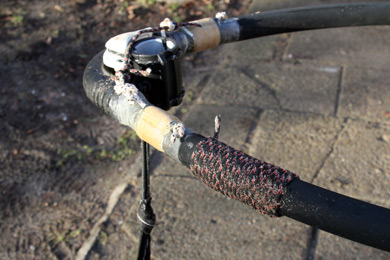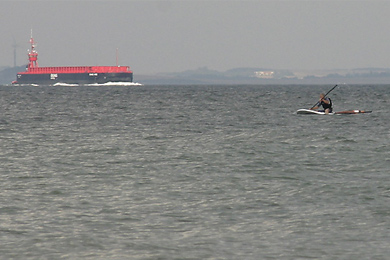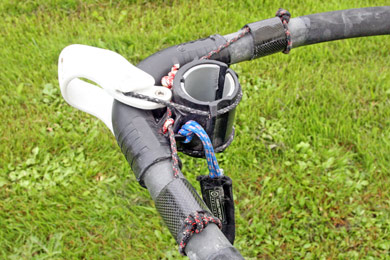| Safety. | |
|
Probably the most important safety precaution is to be mentally prepared that something might go wrong. That is you have to consider that "... maybe it happens today - and what to do if so ... ?" You shall have an answer to all the "what if's" before you disappear towards the horizon, but at the same time you shall be prepared to improvise - and to to it quickly!
The problem is that if anything happens to the gear at sea in the wintertime, you haven't got a lot of time to think about how to solve the problem before you expose yourself to a hyperthermia. Among other things hyperthermia also means a very slow brain, and then it's pretty unusual to make the right decisions.
If for instance the very unlikely(!?) should happen that the race mast should break in your slalom rig, most of us are prone to spend a lot of time to have the mast pieces removed from the sail. to have the sail rolled and placed on the board together with the expensive carbon boom. And many of us have tried and succeeded with this exercise in periods of the year, when time isn't so critical. But in the wintertime, when your brain is minutes away from being paralyzed from cold, you shall very quickly decide, if your life and health aren't more important than the gear (and the lots of lost money) - and consequently if you aren't better helped with leaving the sail (and perhaps save the boom and the unhurt one half of the mast (for a paddle)) and paddle/swim for the shore as soon as possible. On your way back to the coast you might perhaps generate some angry-heat from the fact that you are usually only covered from guaranty if you can show the defect gear for your supplier.
And talking about self-rescue: Still much too few windsurfers have in fact tried to to pack down the equipment and swim/paddle it to the shore in warm and controlled circumstances. When you are left in the cold water with a slow brain you shall realize that some controlled exercises could have helped you to solve the problems almost instinctively.
As indicated it isn't without risks to leave the shore alone in off-shore winds with a fragile race rig (especially certain brands). Such lonely riders are advised to use to use a little more durable equipment - for instance freeride masts instead of full blown slalom or race masts. But furthermore you might consider ...
|
|
|
|
Carbon booms of the kind with a separate front end connecting the two tubes, pretty often happen to break or loosen in the glue. That goes for Nautix and older Fiberspar and Neil Pryde booms. A string secured on both tubes and that goes round the mast guarantees that you can sail back with a broken/defect front end. For the lucky ones who haven't tried: A broken boom front almost always mean a broken rear end and a crash - with a high risk for major damages on the sail and the board. |
 |
It's convenient to bring with you a little rope for repair, for towing, or to pack destroyed gear together before swimming/paddling for the shore. A suggestion for placement of this piece of rope can be in the front part of a boom tube. |
 |
The mast has broken (once
again), and a couple of hours of paddling lie ahead. This time it went
well - it was summertime, the weather was nice, and the buoyancy of the
formula board helped a lot. Photo: Ole Tang. |
